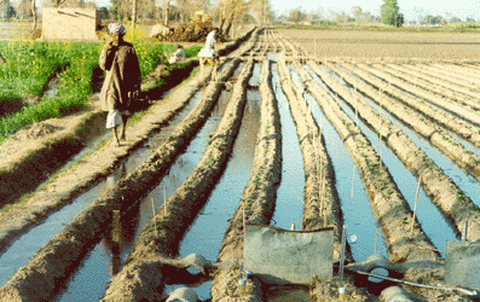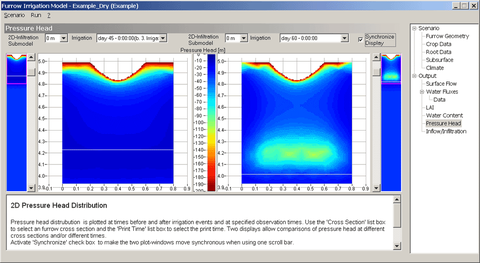Description
Keywords:
Furrow Irrigation, Mathematical Modeling, Efficiency, Optimization, Neuronal Networks, Evolutionary Algorithms
Objectives
Water is a limited resource and the dramatically increasing world population requires a significant increase in food production. The enormous challenge to feed additional 2 billion people in 2030 can only be met by expanding the irrigated agriculture in developing countries. Water consumption will increase by 14 percent in the next thirty years although some developing countries are already using 40% of their renewable freshwater for irrigation. Thus, the FAO calls for a "revolution" in water management in order to improve the generally low water use efficiency in irrigation (about 38%).

furrow irrigation in Pakistan
For improving both crop yield and water use efficiency, the usual optimization strategy in furrow irrigation at the field level considers scheduling parameters, i.e. when and how much to irrigate, as well as control parameters, i.e. the inflow and the cut off time, for each water application. Due to the fact that these parameters are interconnected, they have to be evaluated simultaneously for attaining an optimal water application efficiency. Unresolved problems exist due to the complexity of the optimisation problem and/or rough empirical descriptions of the relevant processes in furrow irrigation.
Methods
The optimization problem in furrow irrigation is difficult to solve, because the target function has many locally optimal solutions and the number of optimization variables, i.e. the number of irrigations is unknown a-priori. Thus, finding the global solution is neither possible with classical deterministic optimisation techniques nor with common modern approaches like simulated annealing (SA) or shuffled complex evolution (SCE-UA). For this reason, a tailored genetic optimisation technique (GA) is employed to find a near-optimal solution of the outer optimization problem (when and how much to irrigate) within acceptable computation time. The GA combines the flexibility to confine the parameter space to valid solutions with the possibility of an extensive parallel processing.

Procedure
The control parameters for each water application on the field (inflow and the cut off time) are calculated by an artificial neural network (ANN) based on self-organized maps (SOM). The new SOM-MIO architecture was developed, which allows performing simulation tasks as well as solving inverse problems after a single training: - the Self-Organizing Map with Multiple Input/Output option. The SOM-MIO approximates the inverse solution of the coupled numerical surface/subsurface flow model and thus, enormously speeds up the overall performance of the complete optimisation tool. Furthermore, the robustness and stability of ANN-based applications could prove to be useful in numerical schemes, such as non-linear optimization or Monte Carlo methods.
Results
We compared different optimization strategies on a real-case irrigation field in France. A limited amount of water had to be distributed with an optimal irrigation schedule by (i) classical optimisation techniques, i.e. dynamic programming plus a water balance model, and (ii) the new strategy consisting of the dynamic furrow irrigation model, genetic algorithm and a neural network. In order to meet a specific yield after a 130 days growing period the required water volume was calculated with the above optimisation strategies. The new strategy required only 65% of the amount of water used by the classical optimization techniques and 75% when compared with a sensor-based irrigation scheduling method.
There is a high potential to increase irrigation efficiency when rigorous physically based modeling and soft-computing optimization methods are combined for controlling on-field water supply in furrow irrigation. This requires both improvements in the realistic modeling of the subsurface flow and predictive crop growth models including the stochastic nature of climate factors. In addition - with respect to the economic and social aspects of rural systems - the optimisation tool needs to be further developed towards a sustainable agricultural water management.

Scenario of irrigation modelled with Hydrus 2D
